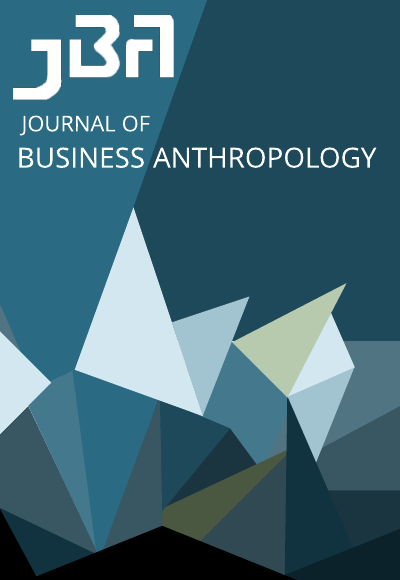Women’s Softball and the Collaborative Spirit of Magic
DOI:
https://doi.org/10.22439/jba.v9i2.6127Abstract
All major US sports are high in superstitions because motivation to win is high and the game outcome is uncertain; athletes purportedly engage in superstitious behavior to reduce anxiety, build individual confidence and cope with uncertainty. Sports is also a male domain, where men traditionally display individual, masculine achievement. We observe magic rituals practiced in a women’s college softball team not as a means to overcome anxiety or display individual prowess, but as a way to blend creative individuality into the unity of the social whole, which manifests as a social narrative of the team. We analyze individual and team magic in two forms –institutionalized magic and individual superstitions – which build idiosyncratic behavior into a collective team dynamic. As such, this essay shows how women use magical power collaboratively. Women on a college softball team partake in practical work and magic, such that participating in magic through empathy and sensing one another creates team identity, allowing the reimagination of forms and outcomes.
References
Besser, Dillon J. 2016. "The Forgotten Party O’Bannon v. National Collegiate Athletic Association: How Non-Revenue Sports Operate in a Changing Intercollegiate Marketplace." Iowa Law Review 101:5, pp 2105-40.
Brown, Daniel 2013. The Boys in the boat: Nine Americans and Their Epic Quest for Gold at the 1936 Berlin Olympics. New York: Penguin.
Bostock, Bill 2020. Female-led countries handled the coronavirus pandemic 'systematically and significantly better' than those run by men, study says. Business Insider, Aug 19, 2020 https://www.businessinsider.com/coronavirus-women-leaders-handled-pandemic-better-than-men-study-2020-8.
Cahn, Susan K. 2015. Coming on Strong: Gender and Sexuality in Women’s Sports 2nd ed. Urbana: University of Illinois Press.
Durkheim, Emile 1965. The Elementary forms of the Religious Life. New York: The Free Press.
Evans-Pritchard, E. E. 1976 (1937). Witchcraft, Oracles and Magic among the Azande. Oxford: Clarendon Press.
Theories of Primitive Religion. Oxford: Clarendon Press.
Ferrante, Karlene. 1994. “Baseball and the Social Construction of Gender.” In Women, Media and Sports, P. Creedon ed. Thousand oaks, CA: sage, pp. 238-256. https://doi.org/10.4135/9781483326764.n9
Graeber, David 2012. “The sword, the sponge and the paradox of performativity: some observations on fate, luck, financial chicanery and the limits of human knowledge.” Social Analysis 56 (1): 25-42. https://doi.org/10.3167/sa.2012.560103
Gmelch, George 1985. Baseball Magic. In Magic, Witchcraft, and Religion: An Anthropological Study of the Supernatural, Lehmann AC and Myers JL (eds)., 5th ed. Mountain View, CA: Mayfield Publishing company.
Greenwood, Susan 2009. The Anthropology of Magic Oxford: Berg.
Haraway, Donna 1991. Simians, Cyborg, and Women: The Reinvention of Nature. London: Free Association Books.
Hasbrouck, Jay 2018. Ethnographic Thinking: From Method to Mindset. New York: Routledge. https://doi.org/10.4324/9780203712290
Huizinga, Johan 1950. Homo Ludens: A study of the play-element in culture. Boston: Beacon.
Ingold, Tim 2013. Making: Anthropology, Archaeology, Art and Architecture. London: Routledge. https://doi.org/10.4324/9780203559055
Knapel, Robert 2012. “Baseball’s 50 Weirdest superstitions,” May 11, 2012 https://bleacherreport.com/articles/1179538-baseballs-50-weirdest-all-time-superstitions.
Kramer, Thomas and Lauren Block, 2014. “Like Mike: ability contagion through touched objects increases confidence and improves performance.” Organizational Behavior and Human Decision Process 124: 215–228. https://doi.org/10.1016/j.obhdp.2014.03.009
Malefyt, Timothy de Waal and Maryann McCabe 2020. “Introduction: Women, Consumption and Paradox.” In Women, Consumption and Paradox. Malefyt and McCabe, eds., pp. 1-24. London and NY: Routledge. https://doi.org/10.4324/9781003028109-1
Malinowski, Bronislaw 1954 [1948]. Magic, Science and Religion and Other Essays. New York, NY: Anchor Books.
Manne, Kate 2020. “There’s Nothing Radical about a Female Vice President.” The New York Times, https://nyti.ms/3jLtakp. July 28, 2020.
Mauss, Marcel 1972 [1902]. A General Theory of Magic. Robert Brain, trans. London: Routledge & Kegan Paul.
Moeran, Brian and Timothy de Waal Malefyt eds. 2018. Magical Capitalism: Enchantment, Spells, and Occult Practices in Contemporary Economies, London: Palgrave Macmillan. https://doi.org/10.1007/978-3-319-74397-4
National Collegiate Athletic Association 2020. NCAA financial database retrieved from ncaa.org/about//resources research/NCAA – finances – database.
Schippers, Michaela and Paul Van Lange 2006. “The Psychological Benefits of Superstitious Rituals in Top Sport: A Study Among Top Sportspersons.” Journal of Applied Social Psychology 36 (10): 2532–2553. https://doi.org/10.1111/j.0021-9029.2006.00116.x
Sennett, Richard 2012. Together: The Rituals, Pleasures and Politics of Cooperation. New Haven, CT: Yale University Press.
Simon, L. 2014. “Why unionizing college sports is a bad call; change at the NCAA can be achieved without turning student-athletes into employees.” Wall Street Journal. Apr 07.
St. James, Yannik, Jay Handelman, and Shirley Taylor 2011. “Magical Thinking and Consumer Coping.” Journal of Consumer Research 38(4): 632–645. https://doi.org/10.1086/660163
Taussig, Michael 1993. Mimesis and Alterity. London: Routledge.
Turner, Victor 1969. The Ritual Process: Structure and Anti-structure. Chicago: Aldine.
Van Maanen, John 2011. Tales of the Field: On Writing Ethnography, second edition. Chicago: University of Chicago Press. https://doi.org/10.7208/chicago/9780226849638.001.0001
Vyse, Stuart 1997. Believing in Magic: The Psychology of Superstition. Oxford: Oxford University Press.
Whiting, Robert 2009. You Gotta Have Wa. Vintage books.
Will, George 2010. Men at Work: The Craft of Baseball. New York: HarperCollins.
Womack, Mari 1992. “Why athletes need a ritual: A study of magic among professional athletes.” In Sport and Religion, Hoffman, S (ed.), pp. 191-202. Champaign, IL: Human Kinetics.
Downloads
Published
Issue
Section
License
Authors who publish with this journal agree to the following terms:
- Authors retain copyright and grant the journal right of first publication with the work simultaneously licensed under a Creative Commons Attribution License that allows others to share the work with an acknowledgement of the work's authorship and initial publication in this journal.
- Authors are able to enter into separate, additional contractual arrangements for the non-exclusive distribution of the journal's published version of the work (e.g., post it to an institutional repository or publish it in a book), with an acknowledgement of its initial publication in this journal.
- Authors are permitted and encouraged to post their work online (e.g., in institutional repositories or on their website) prior to and during the submission process, as it can lead to productive exchanges, as well as earlier and greater citation of published work (See The Effect of Open Access).



